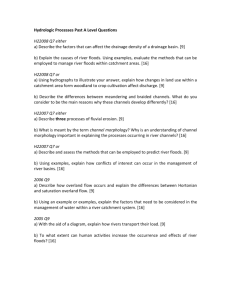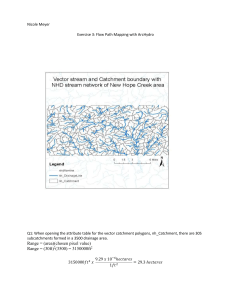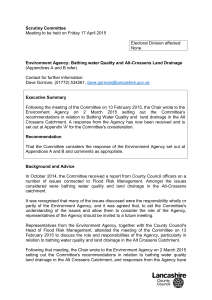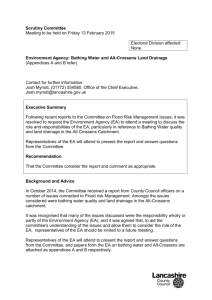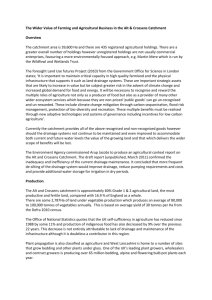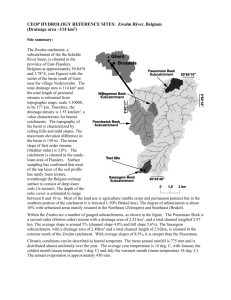AUTOMATED RIVER LINE AND CATCHMENT AREA ... by Wolfgang Rieger
advertisement
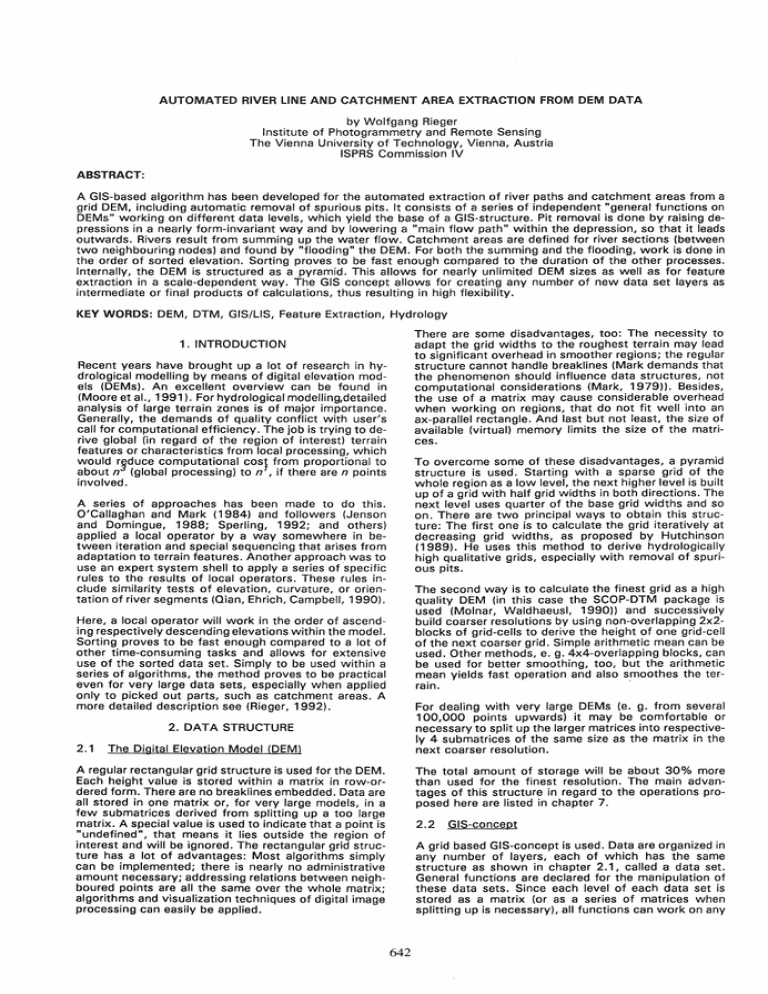
AUTOMATED RIVER LINE AND CATCHMENT AREA EXTRACTION FROM DEM DATA
by Wolfgang Rieger
Institute of Photogrammetry and Remote Sensing
The Vienna University of Technology, Vienna, Austria
ISPRS Commission IV
ABSTRACT:
A GIS-based algorithm has been developed for the automated extraction of river paths and catchment areas from a
grid DEM, including automatic removal of spurious pits. It consists of a series of independent "general functions on
OEMs" working on different data levels, which yield the base of a GIS-structure. Pit removal is done by raising depressions in a nearly form-invariant way and by lowering a "main flow path" within the depression, so that it leads
outwards. Rivers result from summing up the water flow. Catchment areas are defined for river sections (between
two neighbouring nodes) and found by "flooding" the OEM. For both the summing and the flooding, work is done in
the order of sorted elevation. Sorting proves to be fast enough compared to the duration of the other processes.
Internally, the OEM is structured as a pyramid. This allows for nearly unlimited OEM sizes as well as for feature
extraction in a scale-dependent way. The GIS concept allows for creating any number of new data set layers as
intermediate or final products of calculations, thus resulting in high flexibility.
KEY WORDS: OEM, DTM, GIS/US, Feature Extraction, Hydrology
There are some disadvantages, too: The necessity to
adapt the grid widths to the roughest terrain may lead
to significant overhead in smoother regions; the regular
structure cannot handle breaklines (Mark demands that
the phenomenon should influence data structures, not
computational considerations (Mark, 1979)). Besides,
the use of a matrix may cause considerable overhead
when working on regions, that do not fit well into an
ax-parallel rectangle. And last but not least, the size of
available (virtual) memory limits the size of the matrices.
1. INTRODUCTION
Recent years have brought up a lot of research in hydrological modelling by means of digital elevation models (OEMs). An excellent overview can be found in
(Moore et ai., 1991). For hydrological modelling/detailed
analysis of large terrain zones is of major importance.
Generally, the demands of quality conflict with user's
call for computational efficiency. The job is trying to derive global (in regard of the region of interest) terrain
features or characteristics from local processing, which
would r~duce computational COS} from proportional to
about n (global processing) to n , if there are n points
involved.
To overcome some of these disadvantages, a pyramid
structure is used. Starting with a sparse grid of the
whole region as a low level, the next higher level is built
up of a grid with half grid widths in both directions. The
next level uses quarter of the base grid widths and so
on. There are two principal ways to obtain this structure: The first one is to calculate the grid iteratively at
decreasing grid widths, as proposed by Hutchinson
(1989). He uses this method to derive hydrologically
high qualitative grids, especially with removal of spurious pits.
A series of approaches has been made to do this.
Q'Ca"aghan and Mark (1984) and followers (Jenson
and Domingue, 1988; Sperling, 1992; and others)
applied a local operator by a way somewhere in between iteration and special sequencing that arises from
adaptation to terrain features. Another approach was to
use an expert system shell to apply a series of specific
rules to the results of local operators. These rules include similarity tests of elevation, curvature, or orientation of river segments (Qian, Ehrich, Campbell, 1990).
The second way is to calculate the finest grid as a high
quality OEM (in this case the SCOP-DTM package is
used (Molnar, Waldhaeusl, 1990)) and successively
build coarser resolutions by using non-overlapping 2x2blocks of grid-cells to derive the height of one grid-cell
of the next coarser grid. Simple arithmetic mean can be
used. Other methods, e. g. 4x4-overlapping blocks, can
be used for better smoothing, too, but the arithmetic
mean yields fast operation and also s.moothes the terrain.
Here, a local operator will work in the order of ascending respectively descending elevations within the model.
Sorting proves to be fast enough compared to a lot of
other time-consuming tasks and allows for extensive
use of the sorted data set. Simply to be used within a
series of algorithms, the method proves to be practical
even for very large data sets, especially when applied
only to picked out parts, such as catchment areas. A
more detailed description see (Rieger, 1992).
For dealing with very large OEMs (e. g. from several
100,000 points upwards) it may be comfortable or
necessary to split up the larger matrices into respectively 4 submatrices of the same size as the matrix in the
next coarser resolution.
2. DATA STRUCTURE
2.1
The Digital Elevation Model (OEM)
A regular rectangular grid structure is used for the OEM.
Each height value is stored within a matrix in row-ordered form. There are no breaklines embedded. Data are
all stored in one matrix or, for very large models, in a
few submatrices derived from splitting up a too large
matrix. A special value is used to indicate that a point is
"undefined", that means it lies outside the region of
interest and will be ignored. The rectangular grid structure has a lot of advantages: Most algorithms simply
can be implemented; there is nearly no administrative
amount necessary; addressing relations between neighboured points are all the same over the whole matrix;
algorithms and visualization techniques of digital image
processing can easily be applied.
The total amount of storage will be about 30% more
than used for the finest resolution. The main advantages of this structure in regard to the operations proposed here are listed in chapter 7.
2.2
GIS-concept
A grid based GIS-concept is used. Data are organized in
any number of layers, each of which has the same
structure as shown in chapter 2.1, called a data set.
General functions are declared for the manipulation of
these data sets. Since each level of each data set is
stored as a matrix (or as a series of matrices when
splitting up is necessary), all functions can work on any
642
layer in any level. The only restriction is given by the
internal data type used for one single element (byte, or
floating point value) in a specific layer. Elementary
functions may be element-wise addition, subtraction,
multiplication or other fundamental arithmetic operations with matrices only or matrices and constant values. Typical DEM-operations may be calculation of
slope, aspect or curvature in each grid-cell, thus creating matrices of layer slope, aspect and so on. A more
complex function may create a matrix with the size of
the pertinent catchment area in each grid-cell. Or, as a
coded array, the code-number of the catchment area
each grid-cell belongs to.
general, it is assumed that water would overflow pits at
the deepest point along the border of the catchment
area of the pit. This assumption is made by most researchers (O'Caliaghan and Mark 1984, Jenson and
Domingue 1988) because of the lack of information.
Jenson and Domingue (1988) also permit splitting especially of flat areas, if there are more than one outflow
points.
However, only when dealing with the original data, a
more adequate assignment of pits is possible. Hutchinson's procedure produces depressionless DEMs with
regard to the original data and special checking, which
point is the most reliable outflow point (Hutchinson
1989). Another possibility is to use digitized stream
channels (Mark 1988). This is restricted to pits occuring
along stream channels, which are the great majority of
pits. Though, if stream channels shall be automatically
derived from the DEM, it makes little sense to first
digitize them.
This concept allows for easy extension by new functions. Thus, a GIS can be created with a set of general
functions to combine data sets and create new ones.
Data can be transferred from and to existing systems.
Most algorithms can easily be implemented. Methods
and visualization techniques from digital image processing can be used. The concept is highly modular with all
the advantages of these concepts (compare to Jenson
and Domingue, 1988; Johnson, 1989). A series of
functions can be combined to very complex operations.
2.3
3.2
Filling depressions is presented here as one possibility
to obtain a depression less DEM. While Jenson and
Domingue (1988) raise all cells within a pit exactly to
the height of the outflow point and therefore have to
use an additional data set to define water flow, the
"flow direction" of each cell, the concept here is to
largely retain the form of the depression and the height
relations so that the height layer will contain all necessary information for the calculation of water flow.
Surface definition
Each value in a matrix is interpreted as the mean value
of the surrounding grid-cell. Therefore, the expression
"(grid-)cell" is rather used here than "point". Next, transitions are declared between immediately neighbouring
cells. This yields four-connectivity, that means, that
only the four cells immediately adjacent in ax-directions
are taken as neighbours to each single grid-cell. Now,
water flow is defined by height relations between the
adjacent cells (see chapter 4).
Each depression is assigned an entry in a "pit-table",
including the deepest point of the pit, the outflow point,
and the code-number of the catchment area the outflow
point belongs to. The pits are detected in progress with
a catchment searching procedure as described in chapter 6. The height of the outflow point is reduced, while
the deepest point of the pit is raised above the new
height of the sunk outflow point. This is done in a
way that the deepest point of the pit will still be lower
than the old outflow point and the outflow point will
still be higher than its deepest neighbour outside the pit.
This enables raising the pit beginning from the - now
lowered - outflow point, upward to the deepest - now
raised - pit point and going on to the upper edge of the
depression. For numerical reasons, it may be impossible
to reach this constellation: If the outflow point's deepest neighbour has nearly the same height as the outflow
point itself and there is a long way to go to the deepe~t
pit point, a pit would remain, but, ~e r:'~ch flatt.er. T~ls
method shall, in general, preserve Significant height differences and prevent of the formation from new pits.
3. PIT REMOVAL
3.1
Filling depressions
General
Since pits hinder water flow, it is necessary to pay
special attention to them. Completely flat areas will be
treated as pits, too, since water flow is not defined in
these zones.
There are two general types of pits in a DEM: Pits that
represent real depressions at the terrain surface, and
artificial pits, that result from data errors, interpolation
method, or simply from the grid (i.e., if all neighbours of
a grid point happen to be positioned on higher terrain
than the point itself, whileas a flow channel would lead
downwards between two neighbours). Furthermore,
larger water surfaces will result in flat areas.
According to the types of pits, there are two ways to
deal with them: Pits shall either be removed from the
DEM - thus producing a "depressionless DEM" - or they
shall remain. In the latter case water flow stops at the
deepest point within the pit, or, if an underground flow
path and a point of reappearance is known, the accumulated water from the pit's deepest point can be assigned to the reappearance point directly. This is a
special task, that needs for interactive declaration of the
assignment. Because of operator's intervention and
because of the sparse number of such depressions, this
is of minor importance. Mark (1988) notes that depressions on the terrain surface are very rare within a range
of about 10 meters or greater; they will only occur
within special geomorphologic features (e.g. karst).
Filling is done the following way: Starting from the
outflow point's cell and growing into the pit by fronts,
each cell of the pit is changed in height. Each front-ce,"
is directly neighboured to at least one cell of the prevIous front. All cells within a front are sorted according to
their original height values. The lowe~t front cel,l is
assigned a value higher than the respective lower neighbour of the previous front, and all cells of the front
obtain values higher than the respective lower neighbours within the front. For this, an incremental value is
used, that is adapted to the height differenc~ between
the old and the new height of the outflow pOint and the
size of the depression to yield proportionate forms.
The same algorithm can be used to deal with completely flat areas. Here, the sorti~g o! the fro~t is ~one
from the middle of the front outside In both directions.
This is done because of the lack of other information
and yields acceptable results for flat water surfaces.
When dealing with flat terrain, however, better criteria
should be adapted (e.g. in consideration of the pit's
surrounding surface).
The great majority of pits shall be removed to obtain a
depression less DEM. O'Caliaghan and Mark (1984)
proposed to smooth the terrain as a preprocessing task.
This removes only smaller pits and smoothes all the
terrain. A smoothing restricted to depressions is possible, too, but does not remove larger pits, either. In
643
3.3
Lowering a main flow path
not be changed must be marked before the start of the
pit-removal task to be excluded from these operations.
Another way to eliminate pits is to sink a so called main
flow path. One part of this path is found by flooding
water from the outflow point into the pit, until it reaches the deepest pit point. Searching is done by following from each grid-cell to the deepest neighbouring cell
that is not higher than the cell itself. The second part of
the main flow path proceeds from the outflow point
outside the pit, again following to the respective deepest neighbouring cell not higher than its predecessor,
until it reaches terrain that is deeper than the deepest
pit point. Along this path, the height values are changed, so that the grid-cells continuously lead downwards
from the deepest pit point to the outer endpoint of the
path (fig. 1). The main flow path is a channel, that
eliminates the pit, since all cells within the pit can drain
to the deepest pit point's cell and this cell by itself now
can drain outside the pit via the main flow path.
4. CONCEPT OF THE DRAINAGE QUOTA VALUES
To obtain river networks and catchment areas, some
special considerations on the water flow must take
place. Here, a special and very simple local operator is
proposed, that can be used for a good simulation of the
topologic aspects of water flow.
Water always flows in the direction of the steepest
slope. Normally, this direction is not restricted to neighboured grid-cells (4 or 8 neighbours). When working in
the grid DEM, decision must be made to which cell
water would drain. This can lead to gross errors along
larger slopes, because water would arbitrarily float in
direction of the grid.
In reality all deeper neighbours get some part of the
outflow of a grid-cell. A simple method to simulate this
is the use of so-called drainage quota values: The drainage quota value (DQV) is defined as the quota of the
accumulated water in a cell that will be sent to one of
its neighbours. Let woo be the water accumulated in a
grid-cell; wi' the amount of water that flows to one of
the cell's neighbouring cells in 4-connectivity; h, be the
height of neighbour i, ho the height of the grid-cell itself. The drainage accumulation value then can be calculated as (4-connectivity is used, because only 4
neighbouring cells have one common side with the gridcell) :
Wi = Wo -dqvj
(1)
",,,,,,,,,,,,,,,,,,,,,,,,,,,,,,,,,,,,,,,,,,,,,,,,,,,,,,,,,,,,,,,"",,,,,,,,,,,,,,,,,,,,,,,,,,,,,,,,m,fp.,,,,,,,,,,,,,,,,,,,,,,,,,,,,"""""'"
Fig. 1: Pit and main flow path (mfp), longitudinal section. DPP: Deepest pit point; OFP: Outflow point
This algorithm is similar to what is described by O'Callaghan and Mark (1984), except that they only change
the "drainage direction values" and do not change the
height values. Therefore their drainage data set represents the drainage data set of a depression/ess DEM,
the DEM by itself remains unchanged. Here, only the
height data set is used, thus it is changed.
The "drainage quota value", dqv, is defined as:
4-
dqvj = I1h j
j
(2)
j=1
for
with
This method can also be used to deal with systems of
nested pits. For that, the pits have to be eliminated in
the sequence of ascending outflow points. Whenever a
depression is ready for elimination, all its interior depressions already have been dealt with, so that they
drain to the depression's deepest point.
for
First the starting cell is initialized with the water unit.
Next, calculating these values from up to low, a drainage band is obtained. Figure 2a) shows the drainage
band resulting from the drainage quota values, with
white being quota values of (nearly or exactly) 1, gray
of lower than 1, and black with quotas of (nearly or
exactly) O. Figure 2b) shows the result of following the
path of maximum drainage quota values downwards in
4-connectivity.
In most cases this algorithm will produce depressionless
DEMs in one step. Only within flat areas or very large
depressions with small height differences pits may
remain; in this case the algorithm must be repeated.
a
If there are deep depressions, as may arise from improper input data combined with improper interpolation
techniques (e.g. digitized contour lines in broad valleys
with no other height information within the valley),
deep flow gullies may result from this method, that give
an unrealistic surface. In these cases a combination
with the filling method (as described in chapter 3.2) can
be used:
3.4
:E I1h
/
b
Combination - the final algorithm
As a first step, the DEM is smoothed to fill a lot of
single-cell pits. This task is restricted to the pit points
and therefore does not effect the rest of the DEM. It is
furthermore restricted to pits that would not create new
pits in their immediate neighbourhood, when they are
eliminated, thus keeping the changes in the DEM small.
Fig. 2: Drainage in a slope. a) Drainage quota values
(DQV) highlighted; b) Path of maximum DOV's on contour-bands (dark gray lines against light gray zones).
The drainage band is unrealistically wide-spread. This
results from the simplicity of the assumption: In reality,
not all water accumulated in one cell drains to all deeper neighbours as is calculated with the DOVs. Rather,
there is only a channel in which water flows. Figure 3
shows splitting up of these channels by the grid lines
Next, all depressions are filled by the method of raising
fronts (chapter 3.2). Finally, the remaining pits and flat
areas are eliminated by lowering their main flow paths.
This last step must occasionally be repeated to yield a
completely depression less OEM. Depressions that shall
644
tially, two sum-arrays, 81 and 52, all filled with zeroes,
are provided along with the height data set HGT. Now
a rainfall-simulation with constant amount of water over
all the region is made by adding 1 to all grid-cells of 81.
Each grid-cell now contains an amount of one unit of
water. Then in each grid-cell the DOVs to its (deeper)
neighbours are calculated according to equation (2) to
drain its water to these neighbours according to equation (1). These values are summed up in the respective
grid-cells of array 82. When the process is finished, 82
contains in each grid-cell the sum of all water the cell
has received from its higher immediate neighbours.
along a test surface (smooth valley). It is obvious, that
most channels drain only to one single neighbouring
cell.
/. ,s
II til
\ III
This process gives DOVs greater than 1 for concave
zones (valleys), lower than 1 for convex zones (ridges),
and about 1 for (slanted) plains. This yields good impression of the local relief. Larger valleys or ridges,
however, especially if pretty flat, most often cannot be
identified. Thus, iteration is necessary, which simulates
water flow across a landscape (without consideration of
flow velocity, oazing away, ground water, etc.).
,
Fig. 3: Splitting of drainage channels in the grid. 8 is
the starting cell, the arrows show transitions of water.
The channels arise from the edge points around the
grid-cells.
Iteration is done in that the output data set 82 of one
iteration, which contains the accumulated water, is
taken as input data set 81 of the next step of iteration:
Rainfall is simulated by adding values of 1 to each gridcell in the old data set 52, the result written to 51.
Data set 82 then is set to all zeroes, again, and the
calculation of water flow can take part from 81 to 52
as described above. Figures 5a to 5e show different
steps of iterations.
The concept of the DOVs allows for a simultaneous
calculation of all channels, with the only disadvantage
of the unrealistic wide-spread drainage band. The maximum line gives the flow direction. The DOVs can also
be used to calculate the water flow of a greater region,
as will be shown in chapter 5. Furthermore, in chapter
6 it will be shown how to adapt this concept to the
delineation of catchment areas.
5. DERIVING RIVER PATHS
5.1
Test region
Figure 4 shows a test region in a combined representation of contours and hill-shading, created in the following way: At first, the hill-shading value is calculated
for each grid-cell according to Tanaka's algorithm as a
floating point value between 0.0 and 1.0 (Horn, 1982)
and stored in an own data set. Next, the height values
are grouped in zones and another new data set is created that includes varying values dependent on the zones
(here, periodically changing values from 0.4 to 0.6 in 5
steps are applied, each step representing a height zone
of 5m). These two data sets are multiplied and scaled
from the range [0.0 ... 1.0] to the range [0 ... 255].
Fig. 5: a) - e) Steps of iteration of the calculation of the
DOVs in a part of the model of fig. 4; no. of iterations:
a) 1, b) 2, c) 5, d) 10, e) 20.
f) Histogram equalization of picture e).
Fig. 4: Test terrain with hill-shading and overlaid contours
5.2
Iterative calculation of the DOVs
Note that in step n water of all flow paths with lengths
The DOVs can be calculated over the whole DEM. Ini-
645
5.4
of up to n grid-cells (in 4-connectivity) upwards from
each cell contributes to the amount of accumulated
water in that cell. The system is end-iterated, when the
water has reached the edge of the region of interest
along the longest flow path in 4-connectivity. In practice, 20-50 iterations will be enough to yield good results.
The drainage accumulation values pretty well represent
the area of the catchment to each grid-cell, expressed
in numbers of grid-cells. The data set is similar to the
"flow accumulation" data set of O'Caliaghan and Mark
(1984), Jenson and Domingue (1988) and Sperling
(1992) except that here each cell may have more than
one channel for water runoff (the term "drainage accumulation" is used here for distinction to "flow accumulation"). With the flow accumulation data set a
threshold value is used to mark all cells with a higher
value as channel cells. This method is, in principle, also
applied here. However, since water may spread across
flatter areas with the drainage accumulation values,
channel lines may become wider than one single cell or
may be interrupted. For these reasons and besides to
obtain a hierarchical river network structure, channel
lines are traced as follows:
The pictures show no wide-spread drainage bands as
can be observed with single-point drainage (fig. 2a).
The reasons for this are: The drainage bands tend to
lead into valleys and they converge within valleys.
Therefore they are generally not wide-spread as in tilted
plains (fig. 2a). The second reason is, that drainage
bands of neighboured cells tend to balance one another.
The algorithm is best suited for parallel processing. In
each grid-cell, the calculation of the DQVs is independent from one another except that the values have to
be added in array S2. In a mUlti-processor environment,
each processor can work on one part of the array, a socalled "processing region". The only synchronisation
condition is, that two processors should not calculate
within their common border region at the same time.
This can be obtained, if all processors work on their
submatrices in the same row-order.
5.3
Obtaining river networks
Starting from outflow points along the edge of the
terrain (detected as maxima in drainage accumulation
and minima in height along the edge), channels are
persecuted by tracing to all higher (in elevation) neighbours with drainage accumulation values higher than
the specified threshold value. If there are more than one
paths, a temporary node is installed, and all these paths
are traced consecutively, starting with the one with the
highest drainage accumulation value. Then a second
threshold value is used, that represents a minimum
length value for river channels. Channel pieces that are
too short are rejected and the temporary node is deleted. If, however, two channels are long enough, the
node is accepted and the two new channel segments
are inserted. The channel with the larger catchment
area (i.e., the higher drainage accumulation value) is
expected to be part of the same river line as the lower
course, the other one opens a new level in the hierarchy
of the river network.
Ordered calculation
If only sequential processing is available, the iterative
process is very much time-consuming. If, however, the
process is done from top to bottom in the DEM, it can
be finished in one iteration. To do this, an indexing
array is used, containing the matrix addresses of the
grid-cells in sorted order. With efficient sorting algorithms like quicksort, implemented for example as a
standard function in the programming language C, this
sorting is about as time-consuming as a few iterations
of the iterative calculation. Furthermore, there are possibilities to accelerate the sorting task for very large models (see chapter 7).
The procedure is implemented as a recursive algorithm,
thus it will work the same way on each channel cell or
node. Picture 7 shows the river networks obtained by
this algorithm, channel sections shaded in different gray
levels.
The process now works in one single sum-array, referred to as S. At first, rain-fall is simulated by assigning a value of 1 to all grid-cells, as mentioned above.
Next, the DQVs are calculated for the highest grid-cell
and immediately added to its neighbours. As the algorithm works from top downwards, each cell has already
received all water from all cells along all drainage paths
that drain through this cell, when its outflow is calculated. The result from working on all cells, the so-called
"drainage accumulation" data set, is identical to the
result of the end-iterated iterative calculation (except for
numerical inaccuracies). Picture 6 shows the result for
the model of picture 4 and the same with a histogram
equalization (256 gray levels used for data representation).
a.
b
Fig. 7: Channel network obtained by tracing upwards;
part of the model of fig. 4.
Another way to obtain the nodes would be to mark all
cells with drainage accumulation values higher than the
threshold value and a difference in this value to its
higher neighbours, that is also higher than the threshold
(Jenson and Domingue, 1988). This could prevent from
stepping into most short channels, that later on will be
rejected. This has not been tested, however.
6. LABELLING OF CATCHMENT AREAS
Fig. 6: Drainage accumulated by the ordered calculation
in a part of the model of fig. 4. a) Values as calculated:
White means much water (maximum: appr. 5850 units),
black little water. b) Values after a histogram equalization.
!he next step is to label the catchment areas. The job
IS, that all sub-watersheds shall be obtained to all river
sections. O'Callaghan and Mark (1984) and Jenson and
Domingue (1988) assign basin labels for each catchment area, beginning from a starting cell (i.e. an outflow point along the edge of the region)' by recursively
646
assigning the label to all neighbours with flow directions
to already labelled points. Here, a slightly different
algorithm is used utilising the existence of a sorted
indexing array. Work takes place upwards. To each
grid-cell all deeper neighbours (in 4-connectivity) are
examined. The following conditions may occur:
CAY of 1.0000) and numeric 1.0000 (which would
falsely be interpreted as the catchment area with the
next higher code-number, cnr+ 1). Each cell i is assigned a CA V from all deeper neighbours j of the same
catchment area k as follows:
4
kcaVj
1) No deeper neighbours exist.
a) The cell lies at the edge of the region: A new
"global basin" starts.
b) The cell lies within the region (this is impossible
in a depression less OEM): A new depression with
a "pit-basin" starts.
= I:
/Eavij'
Mj
(4)
j=1
dqv is the drainage quota value as defined in equation
(2). The affiliation values are now obtained by working
from bottom to top of the OEM. Each cell's CA V is
calculated from all its deeper neighbours, thus the process can be finished in one step just like the ordered
calculation of the drainage accumulation values.
2) All deeper neighbours belong to the same basin: The
cell is assigned to this basin.
Within the catchment area all points have CA Vs of
exactly 1.0, while in the border regions the CAV will be
lower than 1. In the last case, the cell belongs to more
than one catchment area. Since only one value is provided, the cell is assigned to the catchment area with
the highest affiliation value of all participating basins.
For better results the complement of cavij is adjoined as
the CAY to the other participating catchment areas as
(1-cavij)/n in the neighbour j to point i, if cell i has n
neighbours belonging to other catchment areas. Picture
9a) shows the CAYs for a part of the OEM of picture 4.
Picture 9b) shows the zones with CAYs lower than 1 in
dark gray as an overlay on the terrain.
3) Deeper neighbours belong to different basins: The
cell is marked as a border cell.
4) All deeper neighbours are border cells: The cell is
marked as a border cell, too.
Criterion 1) b) has been inserted for use of this algorithm in the elimination of pits: If a cell meets this criterion, a new entry in the pit-table is created (compare to
chapter 3.2). Following, whenever a cell has deeper
neighbours partly belonging to a pit-basin and a global
basin, this cell becomes outflow point of the participating pit-basin. It is recorded in the respective entry in the
pit-table and the pit-basin is assigned to the participating global basin to prevent from creating further outflow
points for this pit-basin.
a
b
Criteria 2) and 3) do not change, if there are also border
cells involved. Picture 8 shows the result of this labelling procedure on part of the model of picture 4 with all
catchment areas shown in different gray values and the
borderlines in black.
b
Fig. 9: a) Catchment affiliation values (CAVs) in a part
of the terrain of fig. 4. White: CAY = 1, black: CAY = 0,
gray: 0.5::s; CAY < 1. b) Zones with CAY < 1 in dark gray
on the terrain.
Borderlines are found by examining all cells with neighbours belonging to other basins. The respective cells
with the highest height value and the lowest CAY are
marked as border cells. Picture 10 shows the final results, river-courses and catchment borders on the whole
terrain of picture 4.
Fig. 8: Catchment areas and borderlines in a part of the
model of fig. 4. a) Coded areas; b) border lines on terrain.
Obviously, there are some dependencies on the grid
direction, and some borderlines are too broad. Therefore
the concept of the DaVs is adapted as the "catchment
affiliation values" (CAVs):
The base-cell of a catchment area is assigned a CAY of
1 . The same is true for all cells along the marked river
sections, which means, that all these cells completely
belong to the catchment area. For processing reasons,
the label is constructed as follows (cnr be the label
number of the catchment area, cav the CAY in the
respective cell, and label the value finally assigned):
label
=
{
cnr
cnr + cav
for
cav=1
for
cav<1
(3)
Fig. 10: Terrain of picture 4 with river courses (black)
and catchment areas (borderlines in white)
The CA V furthermore is limited to a range of about
0.0001 through 0.9999 to avoid numeric zero for very
small values (which would falsely be interpreted as a
The same algorithm can be used for marking the outflow points of depressions, as mentioned. Within de-
647
for:
pressions, no CAVs need to be calculated, however,
since all cells of the depression fully belong to the depression's basin.
Pit removal: In lower levels there are generally
less pits. Flow directions can then be taken from
pitless zones in lower levels - a priori pitless or
after removing pits - to use the correct outflow
point.
Catchment areas: The approximate knowledge of
the catchment areas in the higher level allows for
work within a single (larger) catchment area.
Within such an area fast river-course extraction is
as well possible as fast sorting and sub-watershed delineation.
River networks: When splitting larger regions, it
is possible to impact drainage accumulation values obtained from lower levels (in regard of the
changed grid cell size) along the edge of a region
section as a constraint. This allows for splitting
very long rivers without loss of information about
its drainage accumulation values.
7. WORK IN PYRAMID STRUCTURE
The upper limit of DEM-sizes is caused by the (virtual)
memory available. A maximum of 3 floating point matrices are to be held in memory simultaneously for the
calculation of the drainage accumulation values in the
iterative process (chapter 3.2) or 2 floating point matrices and one integer array of the same size for the ordered calculation. Most usual word-lengths are 32 bits
for both floating point and integer values, therefore the
indexing array uses the same size as the floating point
array. For 1,000,000 grid-cells, e.g., this means about
12 MB of virtual storage. With modern workstations
this is no real problem in terms of memory usage.
Table 1 lists computing times for one step of the iterative calculation of the drainage accumulation values and
for the sorting of the indexing array in different DEMs of
different sizes. After sorting, the calculation of the
drainage accumulation values will take additional time
of one step of iteration.
INo. of points
10,201
58,081
152,348
231,361
301,101
535,200
1,204,200
liter
0.61
3.81
9.87
15.53
20.48
36.31
87.13
ISort
Overview calculations are possible for quick terrain
analyses. Detailed work then can be restricted to
zones of special interest.
The structure can easily be adapted for data capturing techniques such as progressive sampling.
I
Picture 11 shows a series of the test region of picture
4 calculated in different levels.
1. 02
7.57
20.05
37.03
45.89
86.45
313.02
8. CONCLUSION AND OUTLOOK
Rectangular grid-DEMs in form of matrices can easily be
expanded to grid-GISs. Elementary functions on such
matrices allow for a huge range of applications. Complex problems often relatively simply can be resolved.
Algorithms and visualization techniques of digital image
processing can be used. The extraction of river lines
and catchment areas can be seen as one example of
these features. More complex hydrological modelling
could take place with additional data layers, such as
roughness, soil conditions, slant (for water flow velocity); rainfall layers would allow for simulation of specific
rainfall characteristics, especially in conjunction with a
hill exposition layer.
Table 1 : CPU-times in seconds on a VAX-Station 3100/
M76 with 32 MBytes of main memory under the VMS
operating system. "Iter" means one iteration of iterative
calculation, "Sort" means sorting of indexing array by
the ANSI-C function "qsort". These values are mean
values and may differ about 2% up or down on repeated calculations.
The pyramid data structure proves to be a simple but
efficient means for grid GIS and raster data analyses,
saving the administrative amount of quadtrees and
similar structures. For better accuracy, after the operations have taken place in the grid structure, it is possible to make finer adjustments in regions of special interest, i.e. along the river-courses and the catchment
borders, using vector-based algorithms in hybride or
vector DEMs.
The ordered calculation will take the time of about 3 to
5 steps of the iterative calculation for model sizes up to
over one million of points. This factor includes the time
of calculation of the drainage accumulation value in the
ordered calculation. Thus, the use of sorting is greatly
justified.
Nevertheless it is not commendable to use too large
matrices, since terrain may strongly change in terms of
roughness within larger regions, thus the grid width
should be adapted individually. Furthermore, it is pretty
unwieldy to work on very large matrices, and, overall,
matrices are always limited in size.
For work on very large DEMs (from several 100,000
points upwards), the pyramid structure, as described in
chapter 2, is proposed. When using this structure, the
following advantages result:
Work in different levels corresponds to scale-dependent generalization; it is possible to obtain river
networks in a resolution that corresponds to the
wanted scale.
In each level the same algorithms can be used without any changes.
Data sets of higher levels (finer resolutions) can use
information of those of lower levels. This may allow
for acceleration as well as - in some cases - for
quality improvement. In particular, this can be used
648
Fig. 11:
Test region in 4 levels: 61x61 grid-cells with 200m grid width; 121x121 cells (100m); 241x241 (50m);
481x481 (25m).
and Remote Sensing, The Vienna University of Technology, Austria.
9. REFERENCES
Horn, B. K. P., 1982. Hill shading and the reflectance
map. Geo-Processing 2( 1982): 65-144.
Moore, I.D., Grayson, R.B., Ladson, A.R., 1991. Digital
terrain modelling: A review of hydrological, geomorphological and biological applications. Hydrological Processes, 5(1 ):3-30.
Hutchinson, M.F., 1989. A new procedure for gridding
elevation and stream line data with automatic removal
of spurious pits. Journal of Hydrology, 106(1989):211232.
O'Caliaghan, J.F., Mark, D.M., 1984. The extraction of
drainage networks from digital elevation data. Computer
Vision, Graphics and Image Processing, 28:323-344.
Jenson, S.K., Domingue, J.O., 1988. Extracting topographic structure from digital elevation data for GIS
analysis. Photogrammetric Engineering & Remote Sensing,54(11):1593-1600.
Palacios-Velez, O.L., Cuevas-Renaud, B., 1986. Automated river-course, ridge, and basin delineation from
digital elevation data. Journal of Hydrology, 86(1986):
299-314.
Johnson, L.E., 1989. MAPHYD - A digital map-based
hydrologic modeling system. Photogrammetric Engineering & Remote Sensing, 55(6):911-917.
Gian, J., Ehrich, RW., Campbell, J.B., 1990. DNESYS An Expert System for Automatic Extraction of Drainage
Networks from Digital Elevation Data. IEEE Transactions
on Geosciences and Remote Sensing, 28(1 ):29-45.
Mark, D.M., 1979. Phenomenon-based data-structuring
and digital terrain modelling. Geo-Processing, 1 (1979):
27-36.
Rieger, W., 1992. Hydrologische Anwendungen des
digitalen Gelandemodelles. Dissertation, The Vienna
University of Technology, Vienna, Austria.
Mark, D.M., 1988. Network models in geomorphology,
in Anderson, M.G. (Ed.), Modelling in Geomorphological
Systems, John Wiley, Chichester, England.
Sperling, B., 1992. Darstellung der Moglichkeiten eines
hybriden GIS am Beispiel einer DGM-basierten OberflachenabfluBanalyse. Geo-Information-Systems, 5(1 ):4244.
Molnar, L., Waldhaeusl, P., 1991: Program System
SCOP to create, maintain, and apply digital terrain models. Product information of the Inst. of Photogrammetry
649
